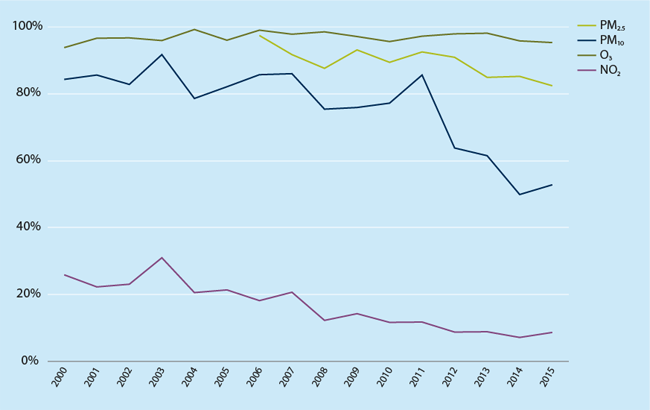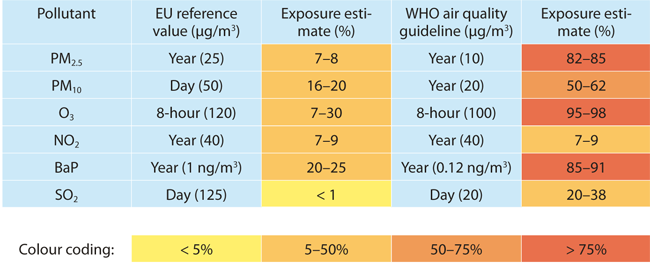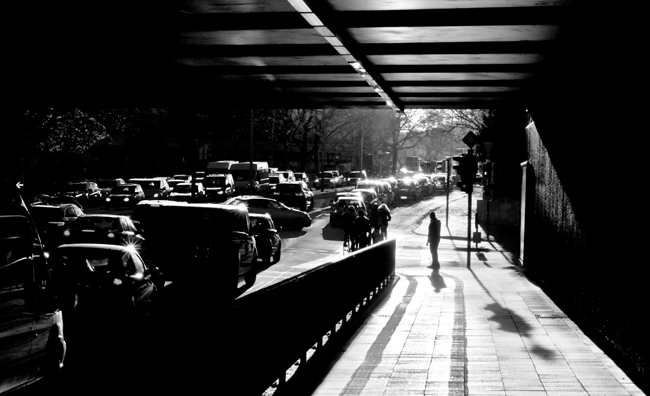Air quality in Europe is slowly improving, but excessive levels of tiny particles are still responsible for more than 400,000 premature deaths every year.
In its annual air quality report the European Environment Agency (EEA) presents new estimates of the health impacts of air pollution based on official data from more than 2,500 monitoring stations across Europe in 2015.
The data show that air quality in Europe is slowly getting better (see figure), but despite these improvements high concentrations of air pollutants, particularly in urban areas, still have significant health impacts, with particulate matter (PM), nitrogen dioxide (NO2) and ground-level ozone (O3) causing the greatest harm.
 Figure: Percentage of EU urban population exposed to air pollutant concentrations above WHO air quality guidelines (2000–2015)
Figure: Percentage of EU urban population exposed to air pollutant concentrations above WHO air quality guidelines (2000–2015)
Moreover, almost all city dwellers continue to be exposed to pollutants at levels deemed unsafe by the World Health Organization (WHO). In 2014, around nine out of ten urban citizens in the EU were exposed to PM2.5 and ozone levels above the WHO guideline values. See Table 1.
Table1. Percentage of EU urban population exposed to air pollutant concentrations above EU and WHO reference levels (2013–2015).
In the 41 countries considered, 428,000 premature deaths in 2014 were attributed to PM2.5 exposure and 78,000 and 14,400 premature deaths to nitrogen dioxide and ozone exposure, respectively. In the EU28, the numbers of premature deaths attributed to PM2.5, NO2 and O3 exposure were 399,000, 75,000 and 13,600, respectively.
Table 2 shows country-by-country the best-estimate figures for total mortality due to exposure to each of the three pollutants, for all the European countries included in the analysis.
Table 2. Estimates of premature deaths attributable to exposure to PM2.5, O3 and NO2 in 41 European countries.

The report also provides country-by-country data on the estimated number of years of life lost (YLL) and the YLL per 100,000 inhabitants due to exposure to the different pollutants.
When considering YLL per 100,000 inhabitants due to PM2.5, the largest impacts are observed in the central and eastern European countries, which is also where the highest concentrations are observed, i.e. Bulgaria, Kosovo, Macedonia, Poland, Serbia, Hungary, Romania, the Czech Republic, and Slovakia.
The largest health impacts attributable to NO2 exposure, expressed as YLL per 100,000 inhabitants, are found in Italy, Serbia, Belgium, the UK, and Germany. Regarding ozone, the countries with the highest rates of YLL per 100,000 inhabitants are Greece, Italy, Malta, Slovenia, and Croatia.
It should be noted that the impacts estimated for each pollutant may not be added to determine the total impact attributable to exposure to the three pollutants. Because concentrations – especially those of PM2.5 and NO2 – are correlated, additions may result in double counting.
On top of the health impacts, air pollution continues to damage vegetation and ecosystems. Elevated concentrations of ground-level ozone damage agricultural crops, forests and plants by reducing photosynthesis. In 2014, the EU’s long-term objective for the protection of vegetation was exceeded in 86 per cent of the total EU agricultural area, and the critical level for the protection of forests was exceeded in 68 per cent of the total EU forest area.
Excess deposition of sulphur and nitrogen compounds (from emissions of SO2, NOx, and NH3) contribute to the acidification of soil, lakes and rivers, causing the loss of biodiversity. In 2014, seven per cent of the European ecosystem area was exposed to acidifying depositions exceeding the limits of nature’s tolerance.
Emissions of NH3 and NOx also disrupt land and water ecosystems by introducing excessive amounts of nutrient nitrogen, causing eutrophication, the oversupply of nutrients, with resulting impacts on biodiversity. In 2014, about 70 per cent of Europe’s ecosystem area was exposed to nitrogen deposition exceeding the critical eutrophication limits.
This year’s report also puts special focus on agriculture, which is an important source of air pollutants (NH3, PM10, PAHs, and NMVOCs) and of greenhouse gases (CH4 and N2O). For example, in 2015, 94 per cent of EU ammonia emissions stemmed from agriculture.
The impact of agricultural emissions on human health is mainly linked to particles, both to primary PM emissions and to the formation of secondary PM from gaseous precursors, mainly ammonia.
A wide range of actions, including technically and economically viable measures, are available to reduce emissions from agriculture but have yet to be adopted at the scale and intensity needed, the report notes. Moreover, measures to abate ammonia would be more effective if they targeted primarily a small number of larger industrial-scale farms, considering that 80 per cent of the EU’s ammonia emissions are generated by less than 10 per cent of the farms.
Christer Ågren
The report “Air quality in Europe – 2017 report” (EEA Report No. 13/2017) is available at: www.eea.europa.eu
































